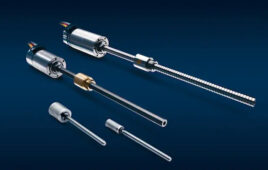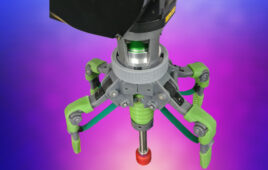|
Listen to this article
|
Assistive technologies include robotics, wearable devices, and the latest advances in artificial intelligence and motion control. Last month, 51 teams from 20 countries competed in the Cybathlon 2020 Global Edition. The fourth year of the contest focused on inclusion and advancing assistive technologies including motorized wheelchairs, exoskeletons, and prostheses such as the Smart ArM.
Because of the COVID-19 pandemic, the teams conducted their demonstrations in their home bases, and the competition was broadcast live. Out of the teams competing, one in four used products from maxon.
Among the teams were researchers at from the Institute of Intelligent Systems and Robotics (ISIR) in Paris. They developed the Smart ArM, a prosthesis for transhumeral amputees (above the elbow). The Smart ArM’s design is the result of several years of research, because the creation of a prosthetic elbow presented a real challenge.
Meeting the needs of people with a particular disability
Less common than forearm or hand amputation, arm amputation has remained relatively unstudied for a long time. It is referred to as above-the-elbow amputation, or total forearm agenesis, which is an absence since birth. Even though this impairment mainly concerns young people who wish to be fitted with a prosthesis, there are currently few suitable prosthetics available.
A team from the ISIR launched a project in 2014. Grouped within the AGATHE team (Assistance au Geste et Applications thérapeutiques), the researchers said they have obtained promising results in upper limb prostheses.
“After attending the first edition of the Cybathlon in 2016 as spectators, we wanted to set up a team to promote our vision and our innovations,” said Nathanaël Jarrassé, ISIR research officer and manager of the Smart ArM project.

The Smart ArM prosthesis is designed for transhumeral amputees (above the elbow). Source: maxon
Smart ArM joins man and machine
The researchers had difficulty finding the ideal candidate. The team found a pilot after a discussion between a collaborator of maxon, a partner of the Cybathlon, and a supplier of engines for the ISIR. They met Christophe Huchet, a former manager of Parisian restaurants who now coaches small and midsize enterprise managers. Born with an agenesis of the right forearm, he was also a multiple champion of handisport swimming, as well as able-bodied competitions.
“This project puts me back into competitive sport and the associated dynamics that I have known well in my swimming career, but this time in the service of a strong cause: helping others and advancing technology and society,” Huchet said. “It is also important for me to take part in this event, which wants to change the way people with braces look at people with braces, to show the extraordinary side of the ‘user-prosthesis’ couple and to promote this alliance of the body and technology which makes the disability beautiful in a way.”
To take part in the Cybathlon, the Smart ArM team was created in 2018. It included a pilot, a manager, a technical team of 11 people from the ISIR and the ISM-Univ Aix-Marseille, as well as a medical team. The project brought together very different fields of research, from mechatronics to computer science, including neuroscience and physiology, to properly interface the prosthesis with the body.
“Our participation in the Cybathlon was motivated by several objectives, including the promotion of ISIR’s technological innovations, tested in the intense context of a competition,” explained Jarrassé. “We also wanted to draw the attention of the general public to these particular disabilities, while communicating the real possibilities and limits of robotic assistive technologies. The Smart ArM project highlights the major role played by humans in the ‘man-machine’ coupling, [since] we often tend to believe that success is due to technology alone.”

Christophe Huchet was the pilot for the ISIR’s Smart ArM team. Source: maxon
Smart ArM team overcomes multiple design difficulties
The Smart ArM team faced several difficulties in getting its pilot off the ground. The biggest one consisted in developing a prosthetic elbow joint known as an “exo-skeletal” that was compatible with Huchet’s anatomy.

The Smart ArM team had to work in a small space. Source: maxon
“Contrary to a residual limb of an arm amputee — generally shortened by the amputation act — his arm is the length of a normal arm and therefore leaves very little room for the installation of a classic endoskeletal elbow prosthetic joint,” Jarrassé said.
The researchers chose to offset the actuation laterally in order to place the axis of the prosthetic elbow joint in an optimal way.
But this was far from being the only challenge posed by the Smart ArM prosthesis. Since it was designed to take part in the Cybathlon, the prototype had to be able to withstand extensive and intense use outside the laboratory. It was therefore necessary to build a robust and fully embedded device.
High motorization constraints
The choice of the prototype’s motorization was crucial, and several parameters had to be considered. The gear motors in the prototype used intermittently but intensely, with worm-wheel transmission for the elbow joint with low efficiency and high dry friction, making starting difficult.
In addition, the developers had to factor in high fluctuations in the supply voltages, as well as shock and vibration because the prototype would be carried by a subject who was running and walking all the time.
Six months of work was necessary to develop the exoskeletal elbow joint of the Smart ArM prosthesis. To operate it, the team chose to use a maxon motor. The ISIR has relied on maxon motors in the past to equip robotic prototypes.

DCX motors. Source: maxon
“A human elbow generates approximately 15N/m of torque with speeds above 150°/s,” said Jarrassé. “To reproduce such characteristics with a small joint and battery operation, we were looking for an extremely high-performance, small-diameter geared motor. That’s why we turned to maxon’s DCX-GPX motor gearbox range.”
“The advantage of maxon products is that they offer a very wide range of small-diameter actuators and market motors with perfectly identified characteristics, which allows optimal dimensioning of our devices during the preliminary design phases,” Jarrassé said. The research teams at the Sorbonne particularly appreciated the ability to build and customize the actuator online, he noted, and maxon’s expert engineers provided technical support.
Related content: The Robot Report Podcast: Robotic prosthetics with Coapt; Dusty Robotics’ Tessa Lau; What’s next for Waymo’s robotaxis
Learning from the Cybathlon
Although it didn’t win a final prize, the Smart ArM team hopes that the demonstration of its know-how during the Cybathlon 2020 will enable development to proceed to commercial products. Jarrassé said he is confident that its innovative approach to prosthesis control, based on body movements, will convince manufacturers to enter into partnerships that would allow the greatest number of people to benefit.
“Developing technology to help people with disabilities, despite the many challenges, is extremely stimulating and exciting,” said Jarrassé. Throughout the project, the Smart ArM team was committed to developing a useful, acceptable and appropriate tool for people who want to be fitted with devices.”
The winners of the Cybathlon 2020 Global Edition, which was conducted by ETH Zurich, included the following:
- Krunoslav Mihic, Team Maker Hand (Croatia) – Powered Arm Prosthesis Race
- Sander Koomen, Team PULSE Racing (Netherlands) – Functional Electrical Stimulation Bike Race
- Florian Hauser, Team HSR enhanced (Switzerland) – Powered Wheelchair Race
- Kim Byeong-Uk, Team Angel Robotics 1 (South Korea) – Powered Exoskeleton Race
- Francesco Bettella, Team WHi (Italy) – Brain-Computer Interface Race
- Andre Frei, Team Circleg (Switzerland) – Powered Leg Prosthesis Race






Tell Us What You Think!